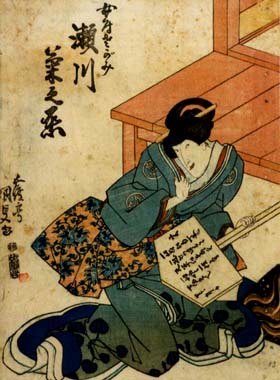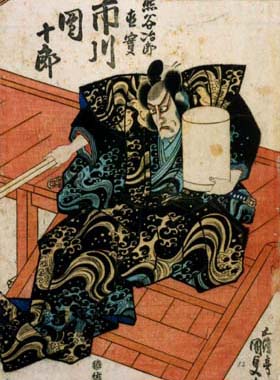| KUMAGAI JIN'YA |
| Play title | Ichi-no-Tani Futaba Gunki |
| Authors | Namiki S˘suke Asada Icch˘ Namioka Geiji Namiki Sh˘z˘ I Naniwa Sanz˘ Toyotake Jinroku |
| History |
The play "Ichi-no-Tani Futaba Gunki" (five acts) was originally written for the puppet theater and staged for the first time in ďsaka at the Toyotakeza in the 12th lunar month of 1751. It was adapted for Kabuki the following year and staged for the first time in Edo at the Moritaza in the 4th lunar month of 1752 [casting]. It was also performed for the first time in ďsaka in the 11th lunar month of 1752 at the Naka no Shibai as a kaomise drama [casting]. |
| Structure | The "Kumagai Jin'ya" scene, which is nowadays the most frequently performed one, is the final scene (kiri) of act III. |
| Key words |
Genpei Kassen Genpei-kassenmono Genji Gidayű Ky˘gen Giri/Ninj˘ Heike Jidaimono Kajiwara Kagetoki Kiri Kubi Jikken Kumagai Naozane Minamoto Yoritomo Minamoto Yoshitsune Taira Atsumori Taira Munekiyo Yaheiby˘e Munekiyo |
| Summary |
Fuji-no-Kata was a lady-in-waiting to the Emperor who was a supporter of the Heike clan. She had, among her ladies, one named Sagami. Sagami fell in love with the Genji warrior Kumagai. For a lady of the court to take a lover was an offense punishable by death. To make matters worse, Kumagai was working for the rival clan. Sagami was already with child, but her mistress, Fuji-no-Kata, took pity on her. With her help the pair were able to flee to Western Japan. Fuji-no-Kata was also at that time pregnant, by the Emperor. She was married shortly afterwards to Taira no Tsunemori, one of the Heike clan, and her child, Atsumori, was brought up as Tsunemori's son. Sixteen years later, destiny brings Kumagai and Atsumori together on the battle field as mortal enemies. In consideration of his debt to Fuji-no-Kata and because of Atsumori's Imperial blood, however, Kumagai cannot bring himself to kill the boy. He decides instead to sacrifice his own son Kojir˘ in place of Atsumori. Later Atsumori's and Kojir˘'s mothers encounter each other at Kumagai's camp. They both realize everything when they see the human head Kumagai is preparing to show General Yoshitsune (1159-1189), the half-brother of Sh˘gun Yoritomo (1147-1199). It is supposed to be the late Atsumori's. Fuji no Kata has mixed feelings of joy for her son's safety and sympathy for the poor Kojir˘. Now sorrow is transferred from Fuji-no-Kata to Sagami. They are interrupted by the sudden entrance of Kajiwara Kagetoki. Aware of what is going on, he threatens to expose the deception to Yoritomo. Yoshitsune, he says, has shut his eyes to Kumagai's plot, but Yoritomo will never permit the fake. Kajiwara goes off the stage in a full rage. A moment later, a scream is heard. Midaroku has killed Kagetoki to spare Yoshitsune the trouble of sullying his hands. This is because he is on Genji's side deep in his heart. When Midaroku is about to go on his way Yoshitsune stops him, calling him "Munekiyo". At first Midaroku pretends he does not know to whom Yoshitsune is speaking. Then the Genji general relates how the great Heike warrior Munekiyo saved the lives of his mother, his brother, and himself when they were caught by the Taira clan. Midaroku admits that he is indeed Munekiyo. It is in an attempt to atone for his fault in sparing the lives of those destined to become the instrument of the Heike's downfall, that he gave up being a samurai and devoted himself to caring for the Heike dead. He says if he had not saved them, Sh˘gun Yoritomo, the head of the Genji family, would not have seen the light of day. Yoshitsune does not resent his words. On the contrary, he intends to help smuggle Atsumori out of Kumagai's camp in return. He, therefore, orders a large case, ostensibly containing armor, but in which Atsumori is hidden, to be brought and presented to Midaroku. In the meantime, Kumagai returns. The shock of his terrible sacrifice to duty and honor makes it impossible for him to continue being a samurai. Now all he wishes to do is to spend the rest of his life praying for the release of his son's spirit. Yoshitsune, deeply grieving, grants his request. From the depth of his sorrow Kumagai cries, "Sixteen years for my son have passed like the dew. It was a dream. Oh, it was merely a dream!" This summary has been written by Watanabe Hisao and edited by Jeff Blair [website] |
| Comments |
The role of the warrior Kumagai Jir˘ Naozane is one of the greatest tachiyaku roles of the current repertoire. It is usually performed by high-skilled and experienced actors like Nakamura Kichiemon, Matsumoto K˘shir˘, Ichikawa Danjűr˘ or Kataoka Nizaemon. "Tamasabur˘ gives an exquisitely touching portrayal of grief as the mother in "Kumagai Jin'ya" ("Kumagai's Camp"), who discovers not only that her son has been beheaded in war, but that her husband (Kanzabur˘) has done the beheading. Remote as this 18th-century drama may initially seem with its insistence on a complex feudal code of honor, the actors distill their emotions to a rare essence, applicable to all ages. The final exit of Kanzabur˘-repentant, broken, bewildered-is one of the singularly great moments of acting anywhere" (from an article written by David Richards for the Washington Post in 1982, referring to the Summer 1982 Kabuki tour in the US with Band˘ Tamasabur˘ and Nakamura Kanzabur˘ XVII in the roles of Sagami and Kumagai Jir˘ Naozane) "General Kumagai is, like all Kabuki tragic heroes, a victim of the medieval Japanese code of honor. Confronted with the prospect of having to kill an Emperor's bastard son, he instead beheads his own son, to comply with the demands of honor and justice. The excerpt we see of the play shows Kumagai returning to his war camp. Here he finds his wife and the mother of the young warrior he is supposed to have slain but in fact saved. In a series of dialogues and monologues the facts are slowly disclosed and the full horror of Kumagai's sacrifice realized. His overlord, approving of his action, releases him from further military service, so that he can spend his last days as a priest. Our last sight of him, this once proud warlord, is as a tonsured priest walking uncertainly into the future while reacting futilely to the alarms to battle which he hears along the way. Destroyed as a man, he is left with nothing but his honor as a lord and faith in Buddha. It is a great part and it has taken magnificently by one of the company's stars, Sh˘roku, who has to perfection this Kabuki skill of acting more with his heart than with his face. Emotion is conveyed within a surprisingly narrow range of facial expressions or even gestures. And yet the agony of this man-contained and idealized as it might also be in, say, a Monteverdi aria-surges with the patent inevitability of accepted fate, an agony too profound even to question why" (from an article written by Clive Barnes for the New York Times in 1969, referring to the Fall 1969 Kabuki tour in the US with Onoe Sh˘roku II in the role of Kumagai Jir˘ Naozane) |
 |
 |
|
The actors Segawa Kikunoj˘ V and Ichikawa Danjűr˘ VII playing the roles of Sagami and Kumagai Jir˘ Naozane in the "Kumagai Jin'ya" scene of the epic drama "Ichi-no-Tani Futaba Gunki", which was performed in the 7th lunar month of 1831 at the Ichimuraza (print made by Utagawa Kunisada I) |
|
| "Kumagai Jin'ya" on YouTube: April 1950 [Kabuki Historical Recordings] | |
|
|
| Contact | Main | Top | Updates | Actors | Plays | Playwrights | Programs | Links | FAQ | Glossary | Chronology | Illustrations | Prints | Characters | Derivatives | Theaters | Coming soon | News |